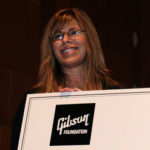 GuitarTown, one of the coolest examples of Marketing as Service I’ve yet to come across, was the brainchild of Nina Miller, now the president of the Gibson Foundation. I had the pleasure of catching up with Nina late last year at the headquarters of Gibson Guitars in Nashville (pretty cool, right?). My interview with Nina follows and though it is long, if you were ever wondering how your company could do well by doing good, it is well worth reading in its entirety.
GuitarTown, one of the coolest examples of Marketing as Service I’ve yet to come across, was the brainchild of Nina Miller, now the president of the Gibson Foundation. I had the pleasure of catching up with Nina late last year at the headquarters of Gibson Guitars in Nashville (pretty cool, right?). My interview with Nina follows and though it is long, if you were ever wondering how your company could do well by doing good, it is well worth reading in its entirety.
DN: Tell me where the idea for GuitarTown came from.
Soon after I moved to Nashville, I saw these little catfish sculptures around town as a public arts program, and I thought, what do catfish have to do with Nashville? So I put together a proposal. And, thanks to the vision and support of our CEO, we were able to start the GuitarTown program – it launched here in Nashville in late 2003.
DN: Why did you think this would work in Nashville?
Because Nashville is such a great music community, obviously, but there are many other aspects to this town, and I thought it would be great to be able to pull the businesses, visual artists and musicians together for a philanthropic cause; so that the 10-foot-tall sculptures would be artistically designed by visual artists, partnered with a business or corporate sponsor and then signed by a celebrity – eventually to be auctioned off for charity.
DN: How do the guitars get sold and where does the money go?
After the auction gala, the funds raised are divided among a variety of non-profit organizations in the host city, so it would stay in the community where it was happening. We’ve raised over $2 million dollars for charity and, of course, it’s great branding for Gibson and Gibson Foundation. 100% of the funds that come into Gibson Foundation from sources outside of Gibson go back out to charity, none of it goes to administrative, or fundraising, that’s all covered by corporate. We’re very fortunate. Many non-profits take up to 20%, for their admin fees so we’re very fortunate not to have to do that, and we try to support a variety of different kinds of organizations in each city.
DN: What other cities have hosted GuitarTown?
Nashville GuitarTown was the first, and then we did Austin, London, Miami, Orlando, and a smaller project, not of 10-foot-tall guitars but of regular size artistically designed ones, that was called Cleveland Rocks. Now we’re doing GuitarTown Sunset Strip in Los Angeles, and that auction is on Dec. 3rd, 2011.
DN: So let’s break it down into a few components; so there’s the creation portion of it, where you have how many guitars? It varies from city to city. Usually it will be no more than 50, typically 25-50, because you can’t really have an auction, a big auction, with fewer products than that. In Nashville we did a “call for artists.” We had a panel that juried all the applications — over 150 applications, and narrowed it to the final 35-40, , but we also included some regular sized guitars, so some people who were unable to design a 10-foot-tall guitar were able to participate as well.
DN: Being associated with Gibson is a cool thing, that’s got to help.
Yes, it opens a lot of doors.
DN: So you’ve got the first phase, which is identifying the artists and announcing the program, what’s next?
Announcing the program, identifying the visual artists, and we were getting video, following a couple of the artists through the process, because it’s very interesting. You can’t do this in a day. I’ve decorated normal size guitars; it takes a good, long while just to do that. To do a 10-foot-tall guitar and to do it well, I would imagine could easily take several months, so these visual artists are doing this, really, for free. We give them a small stipend; we provide opportunities through various arts stores in the area for them to get their supplies, we encourage them to get sponsors for their project as well, because it can be costly.
DN: Is there resistance at all from the cities to say, “well wait, this is Gibson, they should be paying us for this exposure.”
We’ve never run in to anything even remotely like that. We have been welcomed with open arms for beautifying the cities and bringing positive attention.
DN: So it’s a win/win for them?
Right, and although it could be labeled as cause marketing, because it is branding with 100% of the proceeds going to charitable causes; it remains at its core a very charitable project. If we bring in $500,000, or whatever comes in, all of that will go to the designated charities.
DN: So there a display period and then an auction?
Yes. They are strategically placed around the city, or where the city has committed space. Here in Nashville I worked with Public Works to try and determine where we could place them, and we worked with one of the art schools to help keep them in good repair. They also have to be anchored down with heavy sand, and these are not small things, and so, yeah, you work with the different departments of the city. I first asked for permission from the Mayor’s office, and then I kind of figured out from there where to go with it, who to talk to and who to meet with.
DN: What’s the planning cycle for one of these?
For Nashville, I started planning either late 2003 or early 2004, I’d have to go back and look to be certain, but the first thing I did after I got various approvals, was to cold call sponsors, people and businesses I thought would be willing to sponsor the art work and to have it in front of their building. Loews Vanderbilt was the first to say yes, I remember that. And after that it was really easy. And I had help. The Country Music Hall of Fame, BMI and ASCAP were all helping with meeting and event space, we had a committee, that included people from the city as well as the art and music community. A good group of about 10 people to oversee it. We wanted it to be a community effort. And I think it really was. Each city has handled it a little differently, but that was our prototype.
DN: A lot of companies do something cool and then they walk away from it, and say, “what’s the next thing we can do?” What made you stick with this one?
Well, part of it is because the Foundation is in place and we do have this vehicle to promote charitable giving. That’s a big part of it. It’s also great PR and visibility for our iconic brand and it brings much needed attention to several charitable causes in each city.
DN: What caused you to keep going?
I think it was just the program’s success. Other cities came to us and said, “Can you do it here?” I still have people emailing me, even just last week saying, “would you consider here?”
DN: How much does one of these guitars end up going for?
It really depends. When you have one signed by Paul McCartney, and one signed by Dolly Parton, they can go for quite a lot. It depends on the art and the artist – and, of course, the buyer.
DN: So PR is one of the primary ways of measuring success?
Right. I was overseeing the events for Gibson when this started, and then I took off for a year, but stayed involved because I was very dedicated to this program. The person that took it over at that time was our head of PR and she did very well with it as well. So, there is the PR aspect, and the Foundation – the philanthropic aspect. That is very important to all of us here, that’s the key thing for me.
DN: So if a like minded company was thinking of embarking on a program that had a same idea but it was different and appropriate for them, what advice would you give them, in terms of making something like this happen?
Well I can tell you that when I wanted to make this happen I contacted someone in Chicago, I think, and asked for any guidelines that they had so that I could at least have a place to start. There are obviously some rules that we have in place about the artwork: nothing profane, nothing sexual, political or religious, no branding other than our headstock. We’re doing it to create art and raise funds for charitable causes.
I would also recommend finding an image that is meaningful to your city. Music is meaningful to many cities, and in Nashville, LA, Austin and London, it’s a big part of the culture. And find something that connects to the people’s passion. You want to get to the heartstrings of people, make them feel like they’re involved and part of something fun and meaningful.
DN: Music is so universal that you can go to so many different charities and do things like that. I would think that you would focus mainly on music education.
Most people think that and it’s certainly part of our mission, but our CEO, and the Gibson Foundation was his vision, is very philanthropic. He really wanted this to focus on children, globally, to provide opportunities that wouldn’t otherwise exist without the support Gibson Foundation provides. He feels that there is a responsibility on a corporate level give back, and he doesn’t just talk it, he walks it. He’s been very, very supportive. And Dave Berryman, the co-owner and President of the Gibson, oversees the Foundation, they’re both very, involved and very supportive of this.
DN: Tell me a bit more about the PR coverage you’ve received for GuitarTown.
It always gets coverage in every city when it’s happening. Typically a visual artist will be filmed while they’re in the process of creating the sculpture. When the celebrities come out to sign the guitars, that’s another opportunity, and there’s generally a lot of coverage of that on television, in print, on the web, everywhere. And then there’s the gala, and the gala always gets coverage because that’s a big deal.
Sometimes we’ve done red carpet for celebrities, sometimes we just throw the party. It’s all good. And everyone who comes is in great spirits, because they’re there part of something fun and know that when they’re giving, it’s going to charity.
DN: Do you find yourself, when you tell people what you do for a living, that they go, “oh my god that’s the coolest job I’ve ever heard of”?
Every job I’ve had at Gibson, I’ve had that. And here’s the funny thing, every job I’ve had here I’ve actually said, “this is the best gig in the world.” When I started with Events, I had the best gig in the world. When I was head of Entertainment Relations, I was like, “Oh this is heaven.” When I started with the Foundation, I knew it was the best. But I have thought every gig I’ve had here was the best.
DN: That’s amazing. So tell me why it makes it the best, because that just became my headline, The Best Gig in the World. What makes it the best?
You get to do good, you get to be part of something that’s making a major impact in the world, and it’s done in a company as great as Gibson. It just doesn’t get any better than that.
 Climbing way up the tallest building in the world (Dubai’s Burj Khalifa,) one of Tom Cruise’s electronic gloves loses its grip and the hero of the latest “Mission: Impossible” thriller is forced to improvise. At this moment, the viewer is also reminded that technology can only get you so far, at which point it is time for some lifesaving human ingenuity.
Climbing way up the tallest building in the world (Dubai’s Burj Khalifa,) one of Tom Cruise’s electronic gloves loses its grip and the hero of the latest “Mission: Impossible” thriller is forced to improvise. At this moment, the viewer is also reminded that technology can only get you so far, at which point it is time for some lifesaving human ingenuity.


